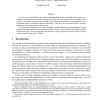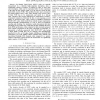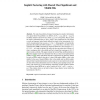290 search results - page 26 / 58 » Pseudorandom Bits for Polynomials |
FCCM
2003
IEEE
14 years 1 months ago
2003
IEEE
Two FPGA based implementations of random number generators intended for embedded cryptographic applications are presented. The first is a true random number generator (TRNG) whic...
CRYPTO
2003
Springer
14 years 1 months ago
2003
Springer
We describe a block-cipher mode of operation, CMC, that turns an n-bit block cipher into a tweakable enciphering scheme that acts on strings of mn bits, where m ≥ 2. When the und...
FOCS
2000
IEEE
14 years 28 days ago
2000
IEEE
A zap is a two-round, public coin witness-indistinguishable protocol in which the first round, consisting of a message from the verifier to the prover, can be fixed “once and...
ICC
2008
IEEE
14 years 2 months ago
2008
IEEE
— Low-Density Parity-Check (LDPC) codes are typically characterized by a relatively high-complexity description, since a considerable amount of memory is required in order to sto...
PKC
2010
Springer
13 years 10 months ago
2010
Springer
We study the problem of integer factoring given implicit information of a special kind. The problem is as follows: let N1 = p1q1 and N2 = p2q2 be two RSA moduli of same bit-size, w...



